Sizes, Components, Crystalline Structure, and Thermal Properties of Starches from Sweet Potato Varieties Originating from Different Countries
Abstract
:1. Introduction
2. Results and Discussion
2.1. Granule Morphology and Size Distribution of Starch
2.2. Iodine Absorption and Amylose Content of Starch
2.3. Crystalline Structure of Starch
2.4. Thermal Properties of Starch
2.5. Relationships of Starch Properties and Cluster Analysis of Sweet Potato Varieties
3. Materials and Methods
3.1. Plant Materials
3.2. Isolation of Starch
3.3. Granule Morphology and Size Analysis of Starch
3.4. Analysis of Starch–Iodine Absorption
3.5. Measurement of Amylose Content
3.6. XRD Analysis of Starch
3.7. DSC Analysis of Starch
3.8. Statistical Analysis
4. Conclusions
Author Contributions
Funding
Institutional Review Board Statement
Informed Consent Statement
Data Availability Statement
Conflicts of Interest
Sample Availability
References
- FAOSTAT. Available online: http://www.fao.org/faostat/en/#data (accessed on 24 October 2021).
- Guo, K.; Liu, T.; Xu, A.; Zhang, L.; Bian, X.; Wei, C. Structural and functional properties of starches from root tubers of white, yellow, and purple sweet potatoes. Food Hydrocoll. 2019, 89, 829–836. [Google Scholar] [CrossRef]
- Moorthy, S.N.; Naskar, S.K.; Shanavas, S.; Radhika, G.S.; Mukherjee, A. Physicochemical characterization of selected sweet potato cultivars and their starches. Int. J. Food Prop. 2010, 13, 1280–1289. [Google Scholar] [CrossRef]
- Song, H.G.; Choi, I.C.; Lee, J.S.; Chung, M.N.; Yoon, C.S.; Han, J. Comparative study on physicochemical properties of starch films prepared from five sweet potato (Ipomoea batatas) cultivars. Int. J. Biol. Macromol. 2021, 189, 758–767. [Google Scholar] [CrossRef] [PubMed]
- Truong, V.D.; Avula, R.Y.; Pecota, K.V.; Yencho, G.C. Sweetpotato production, processing, and nutritional quality. In Handbook of Vegetables and Vegetable Processing; Siddiq, M., Uebersax, M.A., Eds.; John Wiley & Sons Ltd.: Hoboken, NJ, USA, 2018; pp. 811–838. [Google Scholar]
- Emmambux, M.N.; Taylor, J.R.N. Morphology, physical, chemical, and functional properties of starches from cereals, legumes, and tubers cultivated in Africa: A review. Starch 2013, 65, 715–729. [Google Scholar] [CrossRef] [Green Version]
- He, W.; Wei, C. Progress in C-type starches from different plant sources. Food Hydrocoll. 2017, 73, 162–175. [Google Scholar] [CrossRef]
- Hoover, R. Composition, molecular structure, and physicochemical properties of tuber and root starches: A review. Carbohydr. Polym. 2001, 45, 253–267. [Google Scholar] [CrossRef]
- Lindeboom, N.; Chang, P.R.; Tyler, R.T. Analytical, biochemical and physicochemical aspects of starch granule size, with emphasis on small granule starches: A review. Starch 2004, 56, 89–99. [Google Scholar] [CrossRef]
- Wang, H.; Yang, Q.; Ferdinand, U.; Gong, X.; Qu, Y.; Gao, W.; Ivanistau, A.; Feng, B.; Liu, M. Isolation and characterization of starch from light yellow, orange, and purple sweet potatoes. Int. J. Biol. Macromol. 2020, 160, 660–668. [Google Scholar] [CrossRef]
- Yang, Y.; Shi, D.; Wang, Y.; Zhang, L.; Chen, X.; Yang, X.; Xiong, H.; Bhattarai, G.; Ravelombola, W.; Olaoye, D.; et al. Transcript profiling for regulation of sweet potato skin color in Sushu8 and its mutant Zhengshu20. Plant Physiol. Biochem. 2020, 148, 1–9. [Google Scholar] [CrossRef]
- Collado, L.S.; Mabesa, R.C.; Corke, H. Genetic variation in the physical properties of sweet potato starch. J. Agric. Food Chem. 1999, 47, 4195–5201. [Google Scholar] [CrossRef]
- Kim, J.; Ren, C.; Shin, M. Physicochemical properties of starch isolated from eight different varieties of Korean sweet potatoes. Starch 2013, 65, 923–930. [Google Scholar] [CrossRef]
- Zhu, F.; Xie, Q. Rheological and thermal properties in relation to molecular structure of New Zealand sweetpotato starch. Food Hydrocoll. 2018, 83, 165–172. [Google Scholar] [CrossRef]
- Ahmed, S.; Ru, W.; Han, H.; Cheng, L.; Bian, X.; Li, G.; Jin, L.; Wu, P.; Bao, J. Fine molecular structure and its effects on physicochemical properties of starches in potatoes grown in two locations. Food Hydrocoll. 2019, 97, 105172. [Google Scholar] [CrossRef]
- Genkina, N.K.; Noda, T.; Koltisheva, G.I.; Wasserman, L.A.; Tester, R.F.; Yuryev, V.P. Effects of growth temperature on some structural properties of crystalline lamellae in starches extracted from sweet potatoes (Sunnyred and Ayamurasaki). Starch 2003, 55, 350–357. [Google Scholar] [CrossRef]
- Li, H.; Liu, Y. Effects of variety and growth location on the chain-length distribution of rice starches. J. Cereal Sci. 2019, 85, 77–83. [Google Scholar] [CrossRef] [Green Version]
- Tappiban, P.; Sraphet, S.; Srisawad, N.; Wu, P.; Han, H.; Smith, D.R.; Bao, J.; Triwitayakorn, K. Effects of cassava variety and growth location on starch fine structure and physicochemical properties. Food Hydrocoll. 2020, 108, 106074. [Google Scholar] [CrossRef]
- Waramboi, J.G.; Dennien, S.; Gidley, M.J.; Sopade, P.A. Characterisation of sweetpotato from Papua New Guinea and Australia: Physicochemical, pasting and gelatinisation properties. Food Chem. 2011, 126, 1759–1770. [Google Scholar] [CrossRef]
- Zhang, L.; Zhao, L.; Bian, X.; Guo, K.; Zhou, L.; Wei, C. Characterization and comparative study of starches from seven purple sweet potatoes. Food Hydrocoll. 2018, 80, 168–176. [Google Scholar] [CrossRef]
- Guo, K.; Bian, X.; Jia, Z.; Zhang, L.; Wei, C. Effects of nitrogen level on structural and functional properties of starches from different colored-fleshed root tubers of sweet potato. Int. J. Biol. Macromol. 2020, 164, 3235–3242. [Google Scholar] [CrossRef]
- Jane, J.L.; Kasemsuwan, T.; Leas, S.; Zobel, H.; Robyt, J.F. Anthology of starch granule morphology by scanning electron microscopy. Starch 1994, 46, 121–129. [Google Scholar] [CrossRef]
- Lin, L.; Zhang, Q.; Zhang, L.; Wei, C. Evaluation of the molecular structural parameters of normal rice starch and their relationships with its thermal and digestion properties. Molecules 2017, 22, 1526. [Google Scholar] [CrossRef] [Green Version]
- Man, J.; Lin, L.; Wang, Z.; Wang, Y.; Liu, Q.; Wei, C. Different structures of heterogeneous starch granules from high-amylose rice. J. Agric. Food Chem. 2014, 62, 11254–11263. [Google Scholar] [CrossRef]
- Richardson, P.H.; Jeffcoat, R.; Shi, Y.C. High-amylose starches: From biosynthesis to their use as food ingredients. MRS Bull. 2000, 25, 20–24. [Google Scholar] [CrossRef]
- Zhong, Y.; Zhu, H.; Liang, W.; Li, X.; Liu, L.; Zhang, X.; Yue, H.; Xue, J.; Liu, X.; Guo, D. High-amylose starch as a new ingredient to balance nutrition and texture of food. J. Cereal Sci. 2018, 81, 8–14. [Google Scholar] [CrossRef]
- Zheng, Y.; Wang, Q.; Li, B.; Lin, L.; Tundis, R.; Loizzo, M.R.; Zheng, B.; Xiao, J. Characterization and prebiotic effect of the resistant starch from purple sweet potato. Molecules 2016, 21, 932. [Google Scholar] [CrossRef] [Green Version]
- Crofts, N.; Nakamura, Y.; Fujita, N. Critical and speculative review of the roles of multi-protein complexes in starch biosynthesis in cereals. Plant Sci. 2017, 262, 1–8. [Google Scholar] [CrossRef]
- Huang, L.; Sreenivasulu, N.; Liu, Q. Waxy editing: Old meets new. Trends Plant Sci. 2020, 25, 963–966. [Google Scholar] [CrossRef]
- Tian, Z.; Qian, Q.; Liu, Q.; Yan, M.; Liu, X.; Yan, C.; Liu, G.; Gao, Z.; Tang, S.; Zeng, D.; et al. Allelic diversities in rice starch biosynthesis lead to a diverse array of rice eating and cooking qualities. Proc. Natl. Acad. Sci. USA 2009, 106, 21760–21765. [Google Scholar] [CrossRef] [Green Version]
- Cheetham, N.W.H.; Tao, L. Variation in crystalline type with amylose content in maize starch granules: An X-ray powder diffraction study. Carbohydr. Polym. 1998, 36, 277–284. [Google Scholar] [CrossRef]
- Genkina, N.K.; Wasserman, L.A.; Noda, T.; Tester, R.F.; Yuryev, V.P. Effects of annealing on the polymorphic structure of starches from sweet potatoes (Ayamurasaki and Sunnyred cultivars) grown at various soil temperatures. Carbohydr. Res. 2004, 339, 1093–1098. [Google Scholar] [CrossRef]
- Pérez, S.; Baldwin, P.M.; Gallant, D.J. Structural features of starch granules I. In Starch: Chemistry and Technology, 3rd ed.; BeMiller, J., Whistler, R., Eds.; Academic Press: San Diego, CA, USA, 2009; pp. 149–192. [Google Scholar]
- Dhital, S.; Shrestha, A.K.; Hasjim, J.; Gidley, M.J. Physicochemical and structural properties of maize and potato starches as a function of granule size. J. Agric. Food Chem. 2011, 59, 10151–10161. [Google Scholar] [CrossRef] [PubMed]
- Duan, W.; Zhang, H.; Xie, B.; Wang, B.; Zhang, L. Impacts of nitrogen fertilization rate on the root yield, starch yield and starch physicochemical properties of the sweet potato cultivar Jishu 25. PLoS ONE 2019, 14, e0221351. [Google Scholar] [CrossRef] [PubMed] [Green Version]
- Lee, B.H.; Lee, Y.T. Physicochemical and structural properties of different colored sweet potato starches. Starch 2017, 69, 1600001. [Google Scholar] [CrossRef]
- Osundahunsi, O.F.; Fagbemi, T.N.; Kesselman, E.; Shimoni, E. Comparison of the physicochemical properties and pasting characteristics of flour and starch from red and white sweet potato cultivars. J. Agric. Food Chem. 2003, 51, 2232–2236. [Google Scholar] [CrossRef]
- Guo, K.; Zhang, L.; Bian, X.; Cao, Q.; Wei, C. A-, B- and C-type starch granules coexist in root tuber of sweet potato. Food Hydrocoll. 2020, 98, 105279. [Google Scholar] [CrossRef]
- Shi, L.; Li, Y.; Lin, L.; Bian, X.; Wei, C. Effects of variety and growing location on physicochemical properties of starch from wweet potato root tuber. Molecules 2021, 26, 7137. [Google Scholar] [CrossRef]
- Wei, C.; Qin, F.; Zhou, W.; Yu, H.; Xu, B.; Chen, C.; Zhu, L.; Wang, Y.; Gu, M.; Liu, Q. Granule structure and distribution of allomorphs in C-type high-amylose rice starch granule modified by antisense RNA inhibition of starch branching enzyme. J. Agric. Food Chem. 2010, 58, 11946–11954. [Google Scholar] [CrossRef]
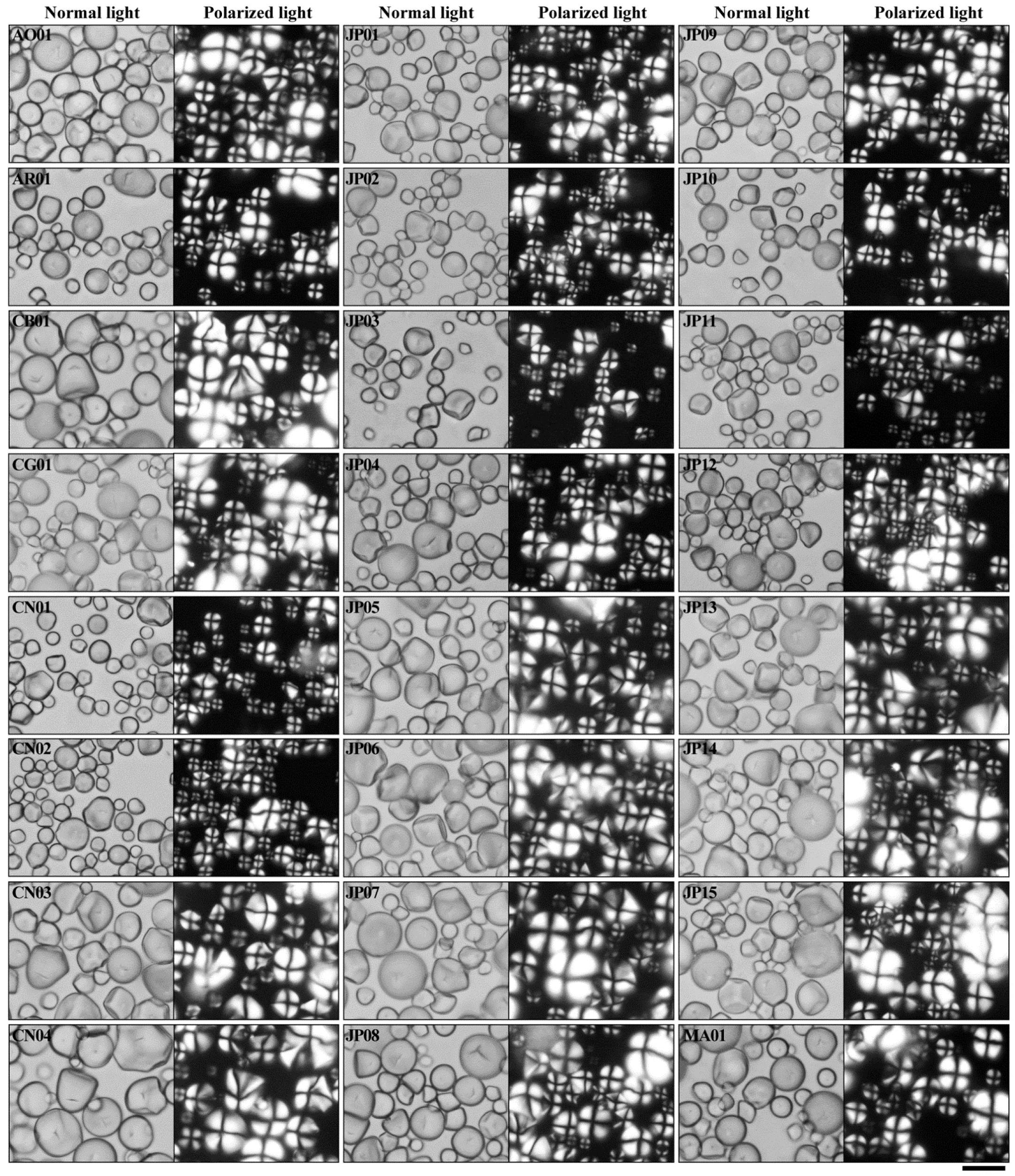
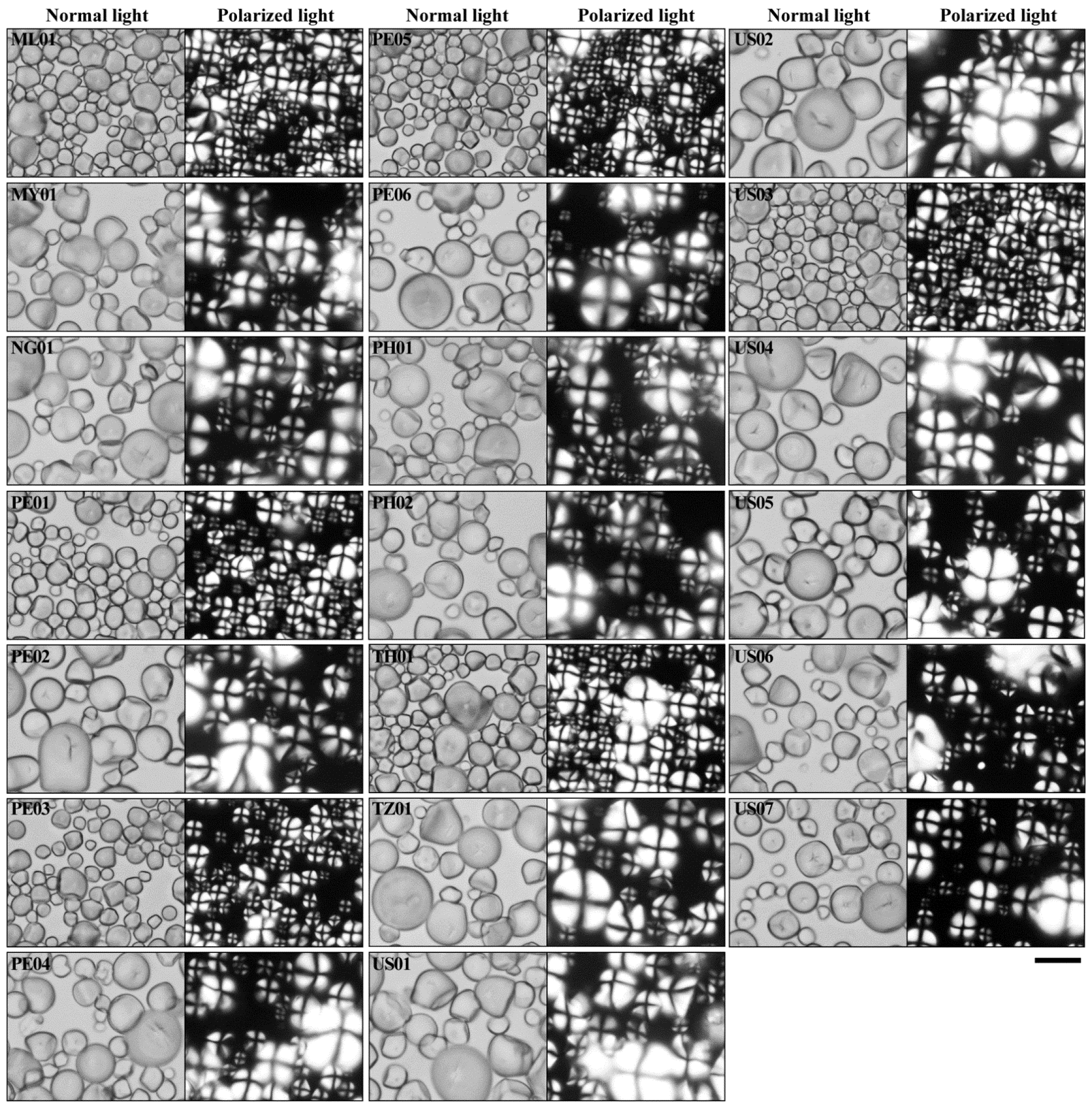
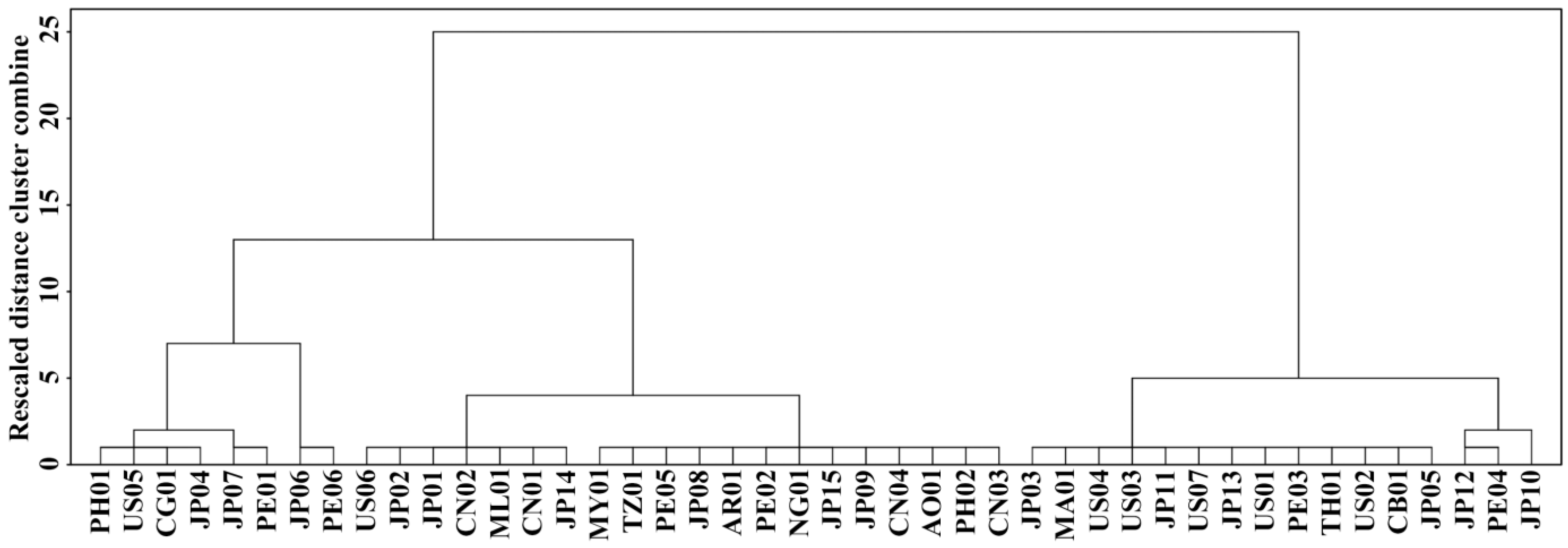
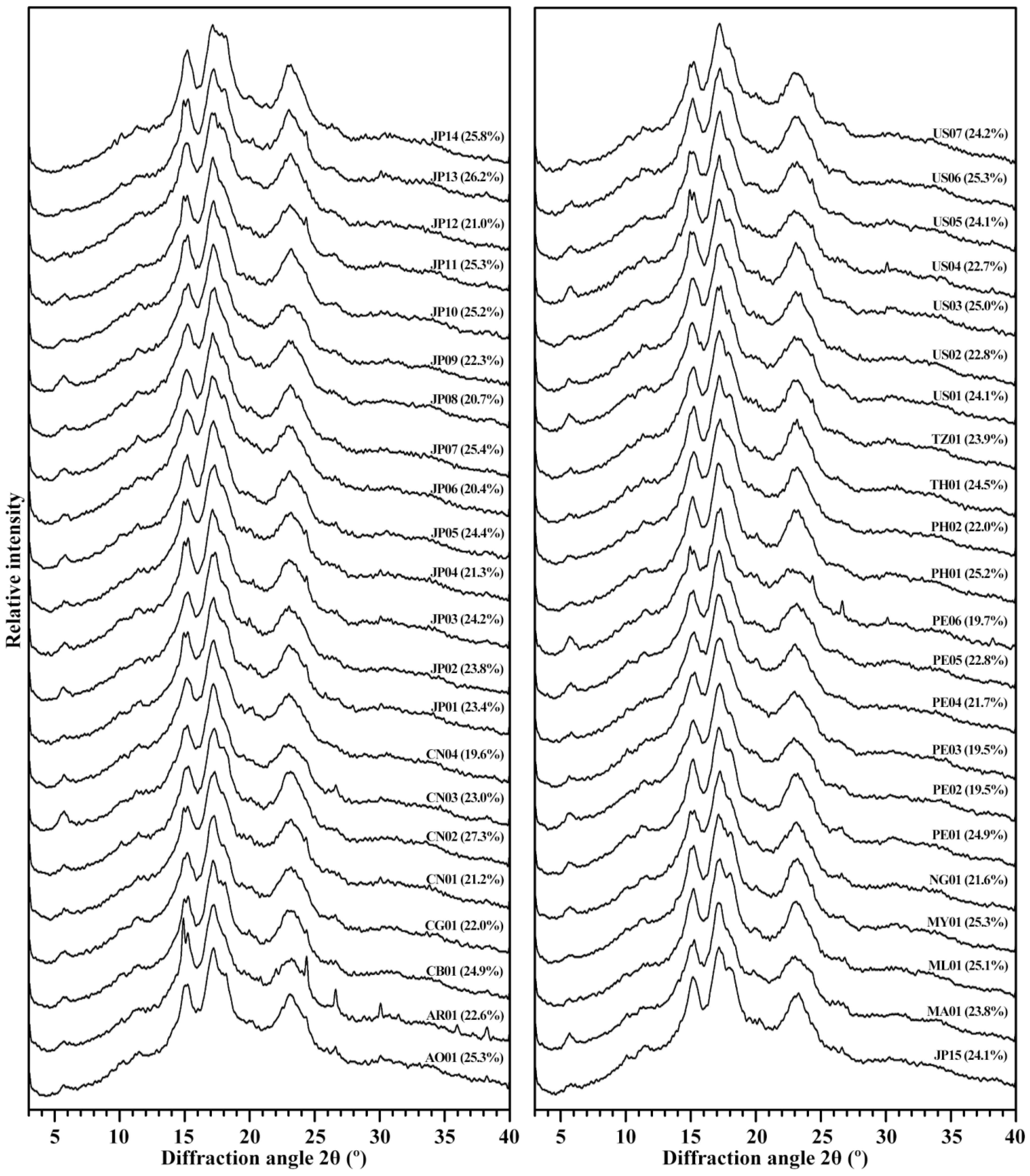
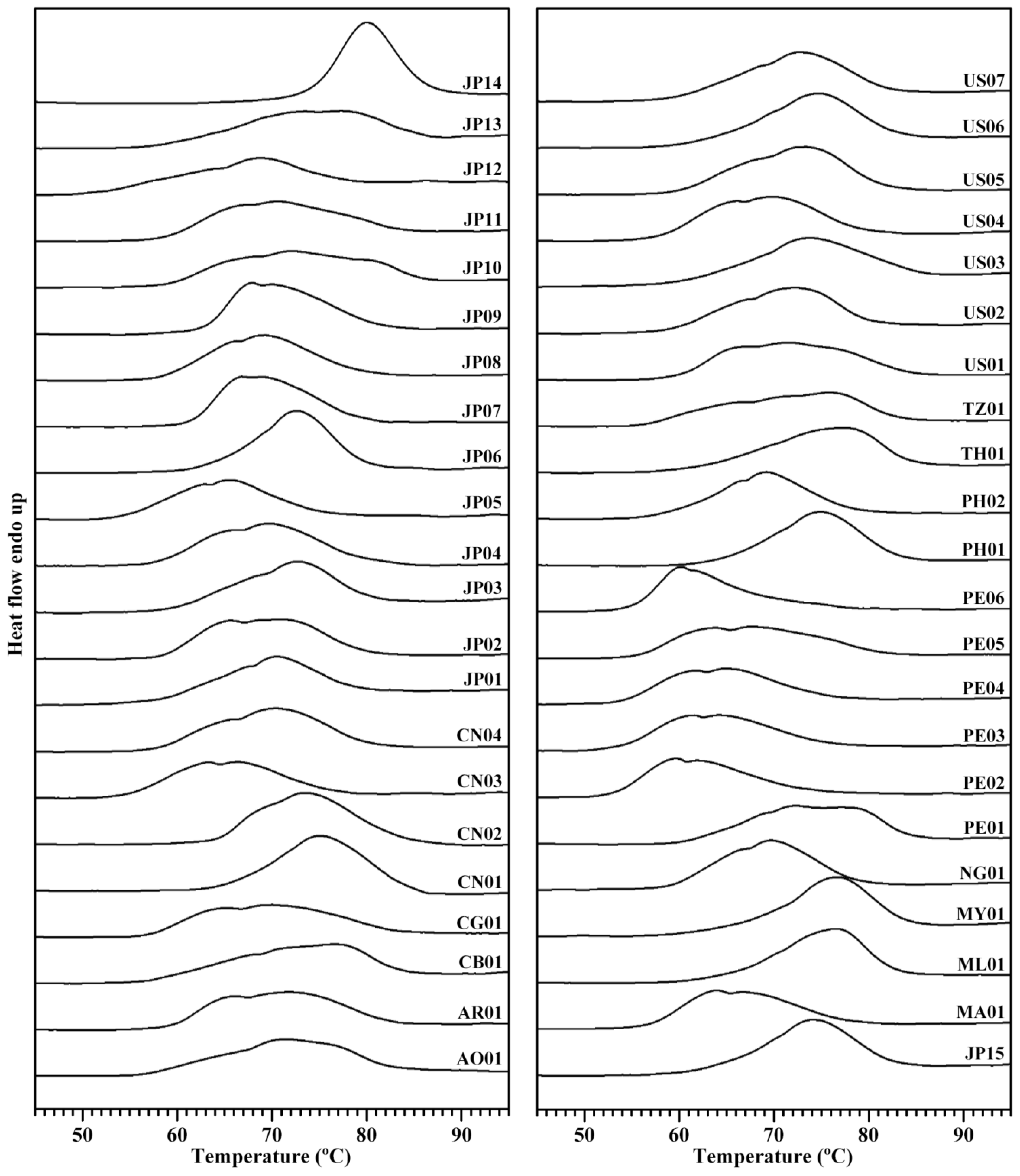
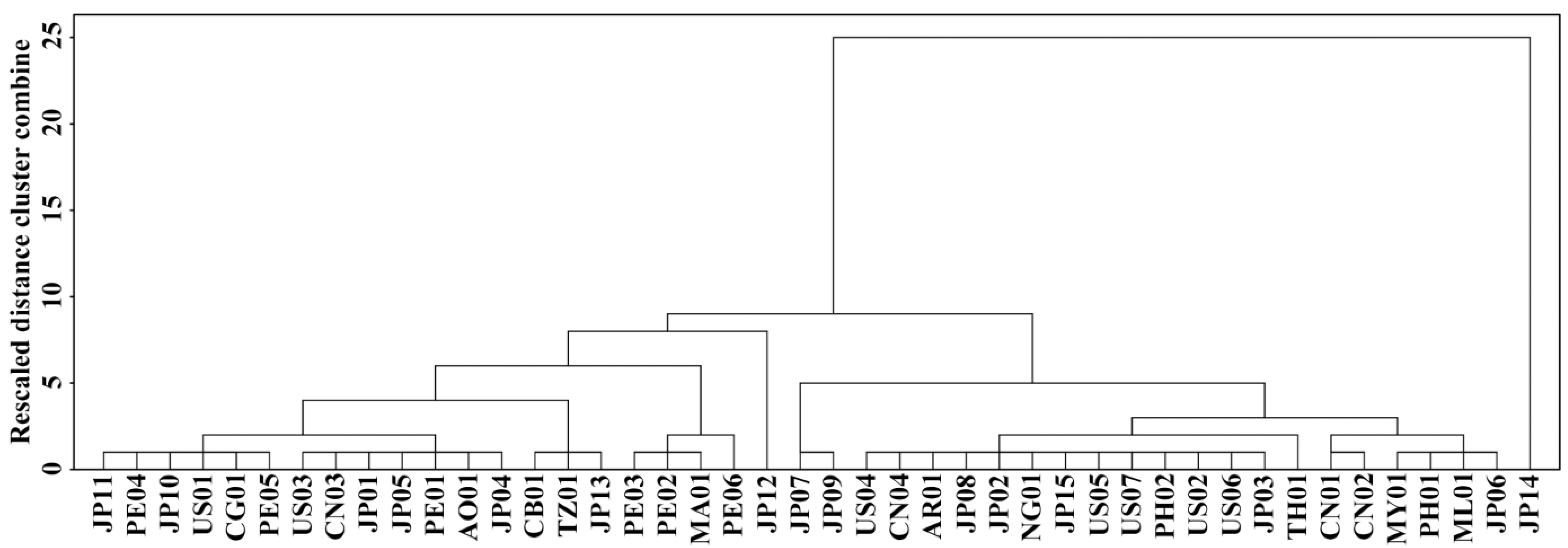
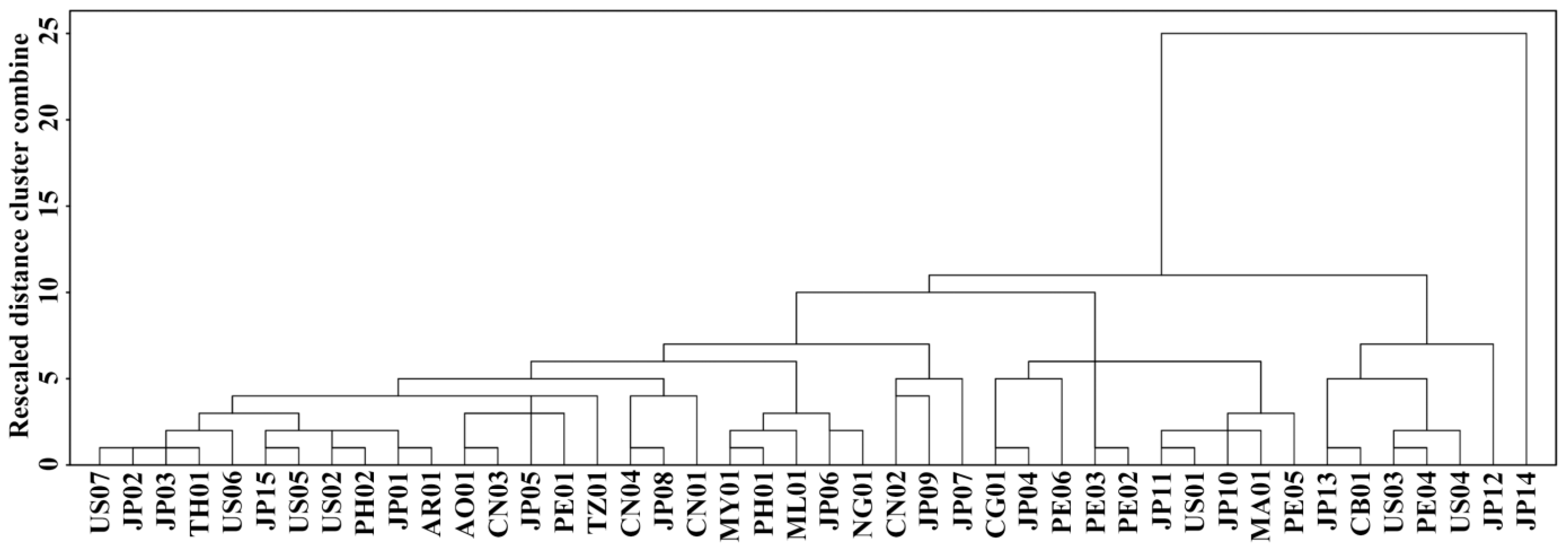
| Accession ID | d(0.2) (μm) | d(0.5) (μm) | d(0.8) (μm) | D[3,2] (μm) | D[4,3] (μm) |
|---|---|---|---|---|---|
| AO01 | 7.573 ± 0.002 mn | 12.817 ± 0.005 tu | 19.452 ± 0.005 γ | 6.226 ± 0.002 s | 13.464 ± 0.004 x |
| AR01 | 7.480 ± 0.002 lm | 10.881 ± 0.003 l | 14.967 ± 0.007 l | 5.986 ± 0.002 o | 11.023 ± 0.005 l |
| CB01 | 7.166 ± 0.002 j | 10.331 ± 0.003 i | 14.071 ± 0.003 h | 5.689 ± 0.002 ij | 10.383 ± 0.003 h |
| CG01 | 6.466 ± 0.001 f | 10.084 ± 0.001 h | 14.492 ± 0.002 i | 5.335 ± 0.001 f | 10.333 ± 0.001 gh |
| CN01 | 7.586 ± 0.020 mn | 10.911 ± 0.036 l | 14.808 ± 0.052 k | 5.732 ± 0.010 l | 10.941 ± 0.036 k |
| CN02 | 7.355 ± 0.003 k | 11.003 ± 0.004 m | 15.402 ± 0.007 m | 5.675 ± 0.003 i | 11.161 ± 0.005 m |
| CN03 | 6.762 ± 0.004 h | 11.099 ± 0.006 n | 16.654 ± 0.006 r | 5.920 ± 0.001 m | 11.648 ± 0.005 o |
| CN04 | 11.111 ± 0.002 z | 14.669 ± 0.001 β | 18.705 ± 0.000 z | 7.612 ± 0.001 ζ | 14.456 ± 0.001 γ |
| JP01 | 7.159 ± 0.001 j | 11.018 ± 0.004 m | 15.878 ± 0.010 o | 6.208 ± 0.003 rs | 11.399 ± 0.006 n |
| JP02 | 6.785 ± 0.003 h | 10.426 ± 0.006 j | 14.935 ± 0.009 l | 5.698 ± 0.002 jk | 10.727 ± 0.006 j |
| JP03 | 5.283 ± 0.003 a | 8.340 ± 0.005 b | 12.391 ± 0.009 e | 4.932 ± 0.003 c | 8.737 ± 0.007 d |
| JP04 | 6.398 ± 0.003 f | 9.227 ± 0.003 f | 12.460 ± 0.003 e | 5.039 ± 0.001 d | 9.185 ± 0.002 e |
| JP05 | 10.568 ± 0.002 y | 14.811 ± 0.003 γ | 19.935 ± 0.005 δ | 7.681 ± 0.001 η | 14.929 ± 0.003 δ |
| JP06 | 8.966 ± 0.001 u | 13.578 ± 0.002 x | 19.356 ± 0.004 γ | 6.946 ± 0.001 z | 13.997 ± 0.003 z |
| JP07 | 7.504 ± 0.001 m | 12.269 ± 0.003 r | 18.221 ± 0.006 x | 6.052 ± 0.001 p | 12.746 ± 0.004 t |
| JP08 | 10.271 ± 0.003 x | 13.945 ± 0.005 z | 18.245 ± 0.008 x | 7.344 ± 0.003 δ | 13.890 ± 0.006 y |
| JP09 | 7.187 ± 0.070 j | 9.931 ± 0.130 g | 13.066 ± 0.167 g | 5.718 ± 0.038 kl | 9.862 ± 0.120 f |
| JP10 | 7.297 ± 0.002 k | 10.948 ± 0.003 lm | 15.379 ± 0.004 m | 5.945 ± 0.002 n | 11.150 ± 0.003 m |
| JP11 | 6.017 ± 0.005 d | 8.651 ± 0.006 d | 11.652 ± 0.009 c | 4.924 ± 0.004 c | 8.623 ± 0.007 c |
| JP12 | 8.211 ± 0.004 r | 12.410 ± 0.003 s | 17.660 ± 0.001 v | 6.764 ± 0.001 x | 12.790 ± 0.002 t |
| JP13 | 5.207 ± 0.021 a | 8.012 ± 0.031 a | 11.189 ± 0.108 a | 3.866 ± 0.011 a | 8.013 ± 0.051 a |
| JP14 | 8.795 ± 0.004 t | 12.749 ± 0.007 t | 17.508 ± 0.012 u | 6.746 ± 0.002 x | 12.922 ± 0.008 u |
| JP15 | 6.978 ± 0.004 i | 10.518 ± 0.006 k | 14.773 ± 0.011 k | 5.551 ± 0.003 h | 10.691 ± 0.008 ij |
| MA01 | 5.855 ± 0.002 c | 8.992 ± 0.005 e | 12.772 ± 0.010 f | 5.083 ± 0.002 e | 9.176 ± 0.006 e |
| ML01 | 7.974 ± 0.004 p | 12.117 ± 0.009 q | 17.128 ± 0.015 s | 6.210 ± 0.003 rs | 12.360 ± 0.010 r |
| MY01 | 9.431 ± 0.004 w | 13.803 ± 0.007 y | 19.183 ± 0.013 β | 7.513 ± 0.002 ε | 14.113 ± 0.009 α |
| NG01 | 7.663 ± 0.005 no | 12.449 ± 0.011 s | 18.598 ± 0.023 y | 6.331 ± 0.004 t | 13.037 ± 0.015 v |
| PE01 | 9.132 ± 0.252 v | 14.378 ± 0.123 α | 20.965 ± 0.166 ζ | 6.968 ± 0.040 α | 14.901 ± 0.016 δ |
| PE02 | 9.038 ± 0.001 uv | 12.832 ± 0.001 u | 17.368 ± 0.002 t | 7.002 ± 0.001 β | 12.955 ± 0.001 u |
| PE03 | 7.392 ± 0.002 kl | 11.090 ± 0.003 n | 15.682 ± 0.003 n | 6.194 ± 0.002 r | 11.391 ± 0.003 n |
| PE04 | 8.187 ± 0.005 qr | 11.730 ± 0.006 p | 15.961 ± 0.007 o | 6.481 ± 0.003 u | 11.857 ± 0.006 q |
| PE05 | 6.663 ± 0.010 g | 10.426 ± 0.013 j | 14.943 ± 0.017 l | 5.470 ± 0.004 g | 10.643 ± 0.013 i |
| PE06 | 5.732 ± 0.002 b | 8.491 ± 0.005 c | 11.799 ± 0.010 d | 4.943 ± 0.003 c | 8.606 ± 0.006 c |
| PH01 | 8.325 ± 0.006 s | 14.328 ± 0.011 α | 22.233 ± 0.011 η | 6.841 ± 0.002 y | 15.296 ± 0.007 ε |
| PH02 | 7.930 ± 0.005 p | 12.871 ± 0.007 u | 19.051 ± 0.008 α | 6.594 ± 0.002 w | 13.409 ± 0.007 x |
| TH01 | 7.754 ± 0.003 o | 11.517 ± 0.005 o | 16.121 ± 0.007 p | 6.313 ± 0.003 t | 11.747 ± 0.005 p |
| TZ01 | 8.105 ± 0.005 q | 13.467 ± 0.008 w | 20.448 ± 0.012 ε | 6.506 ± 0.004 v | 14.211 ± 0.008 β |
| US01 | 5.797 ± 0.002 bc | 8.460 ± 0.003 c | 11.488 ± 0.003 b | 4.682 ± 0.002 b | 8.417 ± 0.002 b |
| US02 | 8.318 ± 0.003 s | 12.302 ± 0.004 r | 17.192 ± 0.009 s | 6.846 ± 0.002 y | 12.583 ± 0.006 s |
| US03 | 7.479 ± 0.003 lm | 12.132 ± 0.008 q | 17.856 ± 0.017 w | 6.124 ± 0.004 q | 12.555 ± 0.011 s |
| US04 | 6.576 ± 0.004 g | 10.584 ± 0.008 k | 15.694 ± 0.014 n | 5.707 ± 0.004 jk | 11.045 ± 0.009 l |
| US05 | 7.362 ± 0.003 k | 11.482 ± 0.006 o | 16.521 ± 0.008 q | 5.929 ± 0.003 mn | 11.792 ± 0.006 p |
| US06 | 9.025 ± 0.001 u | 13.153 ± 0.004 v | 18.263 ± 0.010 x | 7.169 ± 0.001 γ | 13.452 ± 0.006 x |
| US07 | 6.203 ± 0.002 e | 9.900 ± 0.002 g | 14.609 ± 0.002 j | 5.556 ± 0.001 h | 10.321 ± 0.002 g |
| Sig. | 0.322 | 0.410 | 0.671 | 0.849 | 0.422 |
| Accession ID | OD680 | OD620/550 | AAC (%) | TAC (%) | ΔAC (%) |
|---|---|---|---|---|---|
| AO01 | 0.307 ± 0.004 ghijk | 1.164 ± 0.026 abcdefg | 25.6 ± 0.8 ijk | 17.4 ± 0.7 efghi | 8.2 |
| AR01 | 0.324 ± 0.006 klmno | 1.222 ± 0.023 gh | 26.5 ± 0.7 jklm | 17.4 ± 0.2 efghi | 9.1 |
| CB01 | 0.281 ± 0.007 bcd | 1.192 ± 0.004 abcdefgh | 22.2 ± 0.7 cd | 16.4 ± 0.1 cdefgh | 5.8 |
| CG01 | 0.329 ± 0.011 no | 1.157 ± 0.003 abcd | 28.2 ± 0.9 mno | 17.7 ± 0.4 fghi | 10.5 |
| CN01 | 0.300 ± 0.007 efghi | 1.155 ± 0.001 abc | 24.9 ± 0.6 fghij | 17.1 ± 0.2 efghi | 7.8 |
| CN02 | 0.306 ± 0.007 ghijk | 1.160 ± 0.012 abcde | 25.7 ± 0.8 ijkl | 18.2 ± 0.4 hij | 7.5 |
| CN03 | 0.308 ± 0.002 ghijkl | 1.208 ± 0.011 cdefgh | 21.8 ± 0.2 bcd | 14.7 ± 0.3 abc | 7.1 |
| CN04 | 0.295 ± 0.005 defghi | 1.186 ± 0.017 abcdefgh | 23.6 ± 0.5 defgh | 15.7 ± 0.6 abcde | 7.9 |
| JP01 | 0.303 ± 0.004 fghij | 1.183 ± 0.004 abcdefgh | 24.5 ± 0.6 efghi | 17.2 ± 0.4 efghi | 7.3 |
| JP02 | 0.294 ± 0.004 defghi | 1.191 ± 0.007 abcdefgh | 23.5 ± 0.2 defgh | 16.6 ± 0.5 defgh | 6.9 |
| JP03 | 0.291 ± 0.005 cdefgh | 1.218 ± 0.019 efgh | 23.2 ± 0.7 cdef | 17.7 ± 0.3 fghi | 5.5 |
| JP04 | 0.336 ± 0.003 o | 1.185 ± 0.011 abcdefgh | 28.3 ± 0.4 mno | 17.7 ± 0.3 fghi | 10.6 |
| JP05 | 0.299 ± 0.007 defghi | 1.237 ± 0.028 h | 23.4 ± 0.9 cdefgh | 17.1 ± 0.9 efghi | 6.3 |
| JP06 | 0.327 ± 0.007 mno | 1.158 ± 0.015 abcd | 27.9 ± 0.6 mno | 16.1 ± 0.3 bcdefg | 11.8 |
| JP07 | 0.337 ± 0.003 o | 1.186 ± 0.001 abcdefgh | 28.5 ± 0.2 no | 17.2 ± 0.5 efghi | 11.3 |
| JP08 | 0.304 ± 0.001 ghij | 1.174 ± 0.012 abcdefg | 25.0 ± 0.4 fghij | 16.4 ± 0.1 cdefgh | 8.6 |
| JP09 | 0.312 ± 0.007 ijklmn | 1.200 ± 0.006 abcdefgh | 25.5 ± 0.9 ijk | 17.1 ± 0.2 efghi | 8.4 |
| JP10 | 0.304 ± 0.009 ghij | 1.167 ± 0.016 abcdefg | 25.2 ± 1.1 ghij | 20.2 ± 0.9 k | 5.0 |
| JP11 | 0.291 ± 0.006 cdefgh | 1.181 ± 0.002 abcdefgh | 23.4 ± 0.5 cdefgh | 17.6 ± 0.4 efghi | 5.8 |
| JP12 | 0.260 ± 0.005 a | 1.209 ± 0.015 cdefgh | 19.3 ± 0.5 a | 15.0 ± 0.5 abcd | 4.3 |
| JP13 | 0.282 ± 0.003 bcde | 1.189 ± 0.025 abcdefgh | 22.3 ± 0.7 cd | 16.7 ± 0.7 defgh | 5.6 |
| JP14 | 0.326 ± 0.002 mno | 1.169 ± 0.019 abcdefg | 28.3 ± 0.2 nmo | 19.7 ± 0.4 jk | 8.6 |
| JP15 | 0.310 ± 0.008 hijklm | 1.161 ± 0.015 abcdef | 25.8 ± 0.8 ijkl | 17.2 ± 0.3 efghi | 8.6 |
| MA01 | 0.319 ± 0.008 jklmno | 1.192 ± 0.014 abcdefgh | 22.9 ± 0.8 cde | 17.4 ± 0.8 efghi | 5.5 |
| ML01 | 0.303 ± 0.003 fghij | 1.160 ± 0.014 abcde | 25.4 ± 0.5 hijk | 17.4 ± 0.0 efghi | 8.0 |
| MY01 | 0.323 ± 0.008 klmno | 1.142 ± 0.006 a | 27.8 ± 0.4 mno | 18.3 ± 0.6 hij | 9.5 |
| NG01 | 0.325 ± 0.005 lmno | 1.179 ± 0.014 abcdefgh | 27.4 ± 0.6 lmno | 17.8 ± 0.6 fghi | 9.6 |
| PE01 | 0.382 ± 0.013 p | 1.146 ± 0.015 ab | 29.2 ± 1.3 o | 17.7 ± 0.7 fghi | 11.5 |
| PE02 | 0.284 ± 0.008 bcdef | 1.197 ± 0.028 abcdefgh | 22.1 ± 0.7 cd | 14.5 ± 0.3 ab | 7.6 |
| PE03 | 0.281 ± 0.002 bcd | 1.206 ± 0.011 cdefgh | 21.7 ± 0.3 bcd | 16.1 ± 0.6 bcdefg | 5.6 |
| PE04 | 0.259 ± 0.010 a | 1.212 ± 0.021 cdefgh | 19.2 ± 0.9 a | 15.2 ± 0.1 abcd | 4.0 |
| PE05 | 0.296 ± 0.009 defghi | 1.158 ± 0.011 abcd | 24.4 ± 0.8 efghi | 16.0 ± 0.9 bcdef | 8.4 |
| PE06 | 0.303 ± 0.006 fghij | 1.160 ± 0.010 abcde | 25.0 ± 0.6 fghij | 14.2 ± 0.1 a | 10.8 |
| PH01 | 0.331 ± 0.002 o | 1.180 ± 0.010 abcdefgh | 27.8 ± 0.2 mno | 17.7 ± 0.3 fghi | 10.1 |
| PH02 | 0.303 ± 0.007 fghij | 1.190 ± 0.003 abcdefgh | 24.3 ± 0.5 efghi | 16.5 ± 0.7 cdefgh | 7.8 |
| TH01 | 0.299 ± 0.003 defghi | 1.193 ± 0.038 abcdefgh | 24.3 ± 0.2 efghi | 18.0 ± 0.2 ghij | 6.3 |
| TZ01 | 0.320 ± 0.007 jklmno | 1.162 ± 0.044 abcdef | 27.2 ± 0.5 klmn | 17.9 ± 0.1 fghi | 9.3 |
| US01 | 0.298 ± 0.002 defghi | 1.177 ± 0.010 abcdefg | 24.4 ± 0.2 efghi | 18.2 ± 0.4 hij | 6.2 |
| US02 | 0.311 ± 0.003 ijklm | 1.205 ± 0.010 bcdefgh | 25.3 ± 0.3 ghijk | 18.7 ± 0.2 ijk | 6.6 |
| US03 | 0.274 ± 0.008 abc | 1.220 ± 0.018 fgh | 21.5 ± 1.0 bc | 16.2 ± 0.1 bcdefg | 5.3 |
| US04 | 0.270 ± 0.003 ab | 1.203 ± 0.018 bcdefgh | 20.2 ± 0.3 ab | 15.2 ± 0.7 abcd | 5.0 |
| US05 | 0.331 ± 0.007 o | 1.178 ± 0.010 abcdefg | 27.8 ± 0.9 mno | 17.7 ± 0.4 fghi | 10.1 |
| US06 | 0.294 ± 0.003 defghi | 1.215 ± 0.026 defgh | 23.4 ± 0.1 cdefg | 16.6 ± 0.2 defgh | 6.8 |
| US07 | 0.290 ± 0.006 cdefg | 1.193 ± 0.039 abcdefgh | 23.4 ± 0.8 cdefg | 17.5 ± 0.3 efghi | 5.9 |
| Sig. | 0.094 | 0.588 | 0.306 | 0.171 | 0.336 |
| Accession ID | To (°C) | Tp (°C) | Tc (°C) | ΔT (°C) | ΔH (J/g) |
|---|---|---|---|---|---|
| AO01 | 57.4 ± 0.6 fgh | 71.6 ± 0.1 klm | 82.7 ± 0.6 jklmn | 25.3 ± 1.2 klmnop | 13.6 ± 0.1 bcdefghijk |
| AR01 | 59.8 ± 0.6 jklm | 71.8 ± 0.4 lmn | 82.9 ± 0.0 jklmno | 23.2 ± 0.6 ghijklm | 14.3 ± 0.0 fghijklm |
| CB01 | 56.7 ± 0.5 def | 76.5 ± 0.4 vw | 84.5 ± 0.3 nopqr | 27.9 ± 0.2 qr | 14.2 ± 0.3 efghijklm |
| CG01 | 57.3 ± 0.3 efg | 70.5 ± 0.6 ij | 84.2 ± 1.0 mnopqr | 26.9 ± 0.7 opqr | 13.8 ± 0.0 cdefghijkl |
| CN01 | 64.2 ± 0.2 qr | 75.3 ± 0.3 tu | 85.4 ± 0.4 pqrst | 21.3 ± 0.2 cdefgh | 16.9 ± 0.5 o |
| CN02 | 64.0 ± 0.0 pqr | 73.6 ± 0.1 pqr | 84.8 ± 0.4 opqr | 20.8 ± 0.4 cdefg | 16.8 ± 0.5 o |
| CN03 | 54.4 ± 0.2 bc | 65.8 ± 0.7 d | 76.6 ± 1.2 ab | 22.2 ± 1.0 efghi | 12.6 ± 0.3 bcd |
| CN04 | 58.0 ± 0.1 fghi | 70.2 ± 0.0 ij | 80.4 ± 0.1 defgh | 22.5 ± 0.1 efghi | 14.7 ± 0.0 ijklm |
| JP01 | 58.3 ± 0.1 fghij | 70.5 ± 0.1 ij | 81.5 ± 0.4 efghij | 23.3 ± 0.5 ghijklm | 13.0 ± 0.2 bcdefg |
| JP02 | 58.7 ± 0.0 ghijk | 70.6 ± 0.6 ijk | 80.0 ± 0.4 defg | 21.3 ± 0.4 cdefgh | 14.7 ± 0.2 hijklm |
| JP03 | 59.6 ± 0.0 ijkl | 72.9 ± 0.1 op | 82.4 ± 0.8 ijklm | 22.8 ± 0.8 fghijk | 13.7 ± 0.1 cdefghijkl |
| JP04 | 55.6 ± 1.5 cd | 69.9 ± 0.1 hij | 81.7 ± 1.7 fghijk | 26.2 ± 2.2 nopq | 15.0 ± 0.6 jklmn |
| JP05 | 54.3 ± 0.1 bc | 65.7 ± 0.1 d | 75.7 ± 1.1 ab | 21.4 ± 1.2 cdefgh | 12.3 ± 0.0 bc |
| JP06 | 62.4 ± 0.2 no | 72.6 ± 0.1 mno | 80.3 ± 0.3 defgh | 18.0 ± 0.5 b | 14.9 ± 0.3 jklmn |
| JP07 | 61.0 ± 0.4 lmn | 66.8 ± 0.1 e | 79.7 ± 0.1 de | 18.7 ± 0.3 bc | 14.7 ± 0.3 hijklm |
| JP08 | 58.1 ± 0.0 fghij | 69.1 ± 0.1 gh | 80.5 ± 0.5 defghi | 22.4 ± 0.5 efghi | 14.6 ± 0.1 hijklm |
| JP09 | 62.6 ± 0.2 nopq | 68.0 ± 0.1 f | 82.0 ± 0.0 hijkl | 19.5 ± 0.2 bcd | 15.3 ± 0.2 mn |
| JP10 | 59.1 ± 0.1 hijk | 72.1 ± 0.1 mno | 86.1 ± 0.1 rst | 27.0 ± 0.0 pqr | 14.6 ± 0.3 hijklm |
| JP11 | 58.8 ± 0.1 ghijk | 70.8 ± 0.1 jkl | 84.2 ± 0.0 mnopqr | 25.4 ± 0.1 lmnopq | 14.1 ± 0.6 efghijklm |
| JP12 | 52.2 ± 0.3 a | 68.8 ± 0.1 fg | 80.1 ± 0.1 defgh | 27.9 ± 0.1 qr | 10.7 ± 0.5 a |
| JP13 | 57.5 ± 0.0 fgh | 77.1 ± 0.2 wx | 86.7 ± 0.0 st | 29.2 ± 0.0 r | 14.2 ± 0.6 fghijklm |
| JP14 | 73.8 ± 0.0 s | 80.0 ± 0.0 y | 86.9 ± 0.1 t | 13.1 ± 0.1 a | 16.2 ± 0.1 no |
| JP15 | 62.5 ± 0.7 nop | 74.1 ± 0.0 rs | 83.1 ± 0.1 jklmno | 20.6 ± 0.8 cdefg | 14.3 ± 0.1 fghijklm |
| MA01 | 56.8 ± 0.4 def | 63.9 ± 0.1 c | 78.8 ± 0.4 cd | 22.1 ± 0.1 defghi | 12.7 ± 0.0 bcde |
| ML01 | 64.1 ± 1.1 pqr | 76.7 ± 0.3 vwx | 83.6 ± 0.6 klmnop | 19.5 ± 1.8 bcd | 14.1 ± 0.7 efghijklm |
| MY01 | 64.4 ± 1.2 r | 76.8 ± 0.0 vwx | 84.9 ± 0.1 opqrs | 20.5 ± 1.1 cdefg | 15.0 ± 0.7 jklmn |
| NG01 | 59.1 ± 0.0 hijk | 69.9 ± 0.1 hij | 79.3 ± 0.2 d | 20.2 ± 0.2 bcdef | 14.0 ± 0.2 defghijklm |
| PE01 | 60.3 ± 0.0 klm | 72.5 ± 0.4 mno | 84.7 ± 0.6 opqr | 24.4 ± 0.6 ijklmno | 14.7 ± 0.2 hijklm |
| PE02 | 53.3 ± 0.3 ab | 59.9 ± 0.2 a | 75.3 ± 0.1 a | 22.0 ± 0.2 defghi | 13.0 ± 0.3 bcdefg |
| PE03 | 53.9 ± 0.0 b | 61.4 ± 0.1 b | 76.5 ± 0.8 ab | 22.6 ± 0.8 efghij | 12.8 ± 0.2 bcde |
| PE04 | 54.6 ± 0.5 bc | 65.0 ± 0.0 d | 77.4 ± 0.6 bc | 22.9 ± 0.1 fghijkl | 12.3 ± 0.1 b |
| PE05 | 55.8 ± 0.1 cde | 67.9 ± 0.3 f | 81.8 ± 0.3 fghijk | 26.1 ± 0.4 nopq | 13.3 ± 0.1 bcdefghi |
| PE06 | 54.8 ± 0.3 bc | 59.7 ± 0.7 a | 77.2 ± 0.2 bc | 22.4 ± 0.1 efghi | 12.9 ± 0.7 bcdef |
| PH01 | 63.8 ± 0.2 opqr | 75.0 ± 0.1 st | 83.6 ± 0.2 klmnop | 19.8 ± 0.0 bcde | 14.9 ± 0.5 jklmn |
| PH02 | 57.8 ± 0.1 fgh | 69.6 ± 0.4 ghi | 78.8 ± 0.1 cd | 21.0 ± 0.0 cdefg | 13.2 ± 0.1 bcdefgh |
| TH01 | 61.0 ± 0.2 lmn | 77.5 ± 0.0 x | 84.9 ± 0.1 opqrs | 23.9 ± 0.3 hijklmn | 15.1 ± 0.5 klmn |
| TZ01 | 56.6 ± 0.1 def | 76.0 ± 0.0 uv | 84.0 ± 0.4 lmnopq | 27.4 ± 0.5 pqr | 13.5 ± 0.1 bcdefghij |
| US01 | 60.2 ± 0.1 klm | 71.8 ± 0.4 lmn | 85.3 ± 0.6 pqrst | 25.1 ± 0.6 jklmnop | 14.9 ± 0.1 jklmn |
| US02 | 59.0 ± 1.0 ghijk | 71.6 ± 0.7 klmn | 80.6 ± 0.1 defghi | 21.6 ± 1.1 defgh | 13.7 ± 0.3 cdefghijk |
| US03 | 60.3 ± 0.1 klm | 74.0 ± 0.3 qrs | 85.8 ± 0.8 qrst | 25.5 ± 0.9 mnopq | 14.4 ± 0.3 ghijklm |
| US04 | 57.9 ± 0.1 fghi | 69.9 ± 0.1 hij | 79.9 ± 0.1 def | 22.0 ± 0.1 defghi | 14.9 ± 0.3 jklmn |
| US05 | 60.0 ± 0.1 klm | 73.1 ± 0.1 opq | 81.9 ± 0.3 ghijk | 21.9 ± 0.1 defghi | 15.2 ± 0.5 lmn |
| US06 | 61.4 ± 0.7 mn | 74.5 ± 0.4 rst | 83.6 ± 0.1 klmnop | 22.2 ± 0.8 defghi | 14.3 ± 0.9 fghijklm |
| US07 | 59.5 ± 0.0 ijkl | 72.7 ± 0.4 nop | 82.0 ± 0.3 hijkl | 22.5 ± 0.3 efghi | 14.2 ± 0.5 efghijklm |
| Sig. | 0.009 | 0.180 | 0.189 | 0.128 | 0.224 |
| D[4,3] | OD680 | OD620/550 | AAC | TAC | RC | Tp | Tc | |
|---|---|---|---|---|---|---|---|---|
| OD680 | 0.273 | |||||||
| OD620/550 | −0.066 | −0.501 ** | ||||||
| AAC | 0.251 | 0.908 ** | −0.619 ** | |||||
| TAC | 0.006 | 0.483 ** | −0.304 * | 0.593 ** | ||||
| RC | −0.036 | 0.164 | −0.106 | 0.187 | 0.583 ** | |||
| Tp | 0.122 | 0.183 | −0.300 * | 0.343 * | 0.602 ** | 0.625 ** | ||
| Tc | −0.144 | 0.201 | −0.416 ** | 0.354 * | 0.646 ** | 0.632 ** | 0.858 ** | |
| ΔT | −0.327 * | −0.289 | 0.070 | −0.323 * | −0.113 | 0.018 | −0.015 | 0.205 |
| ΔH | −0.029 | 0.372 * | −0.423 ** | 0.522 ** | 0.498 ** | 0.338 * | 0.590 ** | 0.623 ** |
| Accession ID Used in This Study | Origin Accession ID in China National Sweetpotato Genebank | Accession Name without Origin Accession ID in China National Sweetpotato Genebank | Original Area |
|---|---|---|---|
| AO01 | Angola | Angola | |
| AR01 | SY00332 | Argentina | |
| CB01 | Cambodia 1 | Cambodia | |
| CG01 | Congo 2 | Congo | |
| CN01 | SY00018 | China | |
| CN02 | SY00019 | China | |
| CN03 | SY00192 | China | |
| CN04 | SY00215 | China | |
| JP01 | SY00075 | Japan | |
| JP02 | SY00081 | Japan | |
| JP03 | SY00083 | Japan | |
| JP04 | SY00087 | Japan | |
| JP05 | SY00145 | Japan | |
| JP06 | SY00147 | Japan | |
| JP07 | SY00148 | Japan | |
| JP08 | SY00159 | Japan | |
| JP09 | SY00369 | Japan | |
| JP10 | Ayamurasaki | Japan | |
| JP11 | Hongyao 2 | Japan | |
| JP12 | Hongyou | Japan | |
| JP13 | Japanese Black | Japan | |
| JP14 | Kokei 14 | Japan | |
| JP15 | Okinawa 100 | Japan | |
| MA01 | SY00089 | Morocco | |
| ML01 | SY00091 | Mali | |
| MY01 | SY00130 | Malaysia | |
| NG01 | SY00219 | Nigeria | |
| PE01 | SY00175 | Peru | |
| PE02 | SY00183 | Peru | |
| PE03 | SY00190 | Peru | |
| PE04 | SY00283 | Peru | |
| PE05 | Peru 1 | Peru | |
| PE06 | Peru 384 | Peru | |
| PH01 | SY00114 | Philippines | |
| PH02 | SY00118 | Philippines | |
| TH01 | Taizi 1506 | Thailand | |
| TZ01 | Tanzania | Tanzania | |
| US01 | SY00001 | United States | |
| US02 | SY00003 | United States | |
| US03 | SY00004 | United States | |
| US04 | SY00006 | United States | |
| US05 | SY00014 | United States | |
| US06 | SY00025 | United States | |
| US07 | SY00277 | United States |
| Month | Average Low Temperature (°C) | Average High Temperature (°C) | Total Rainfall (mm) |
|---|---|---|---|
| Apr | 10 ± 4 | 21 ± 4 | 16 |
| May | 18 ± 3 | 27 ± 5 | 36 |
| Jun | 22 ± 2 | 30 ± 4 | 340 |
| Jul | 22 ± 2 | 29 ± 3 | 359 |
| Aug | 25 ± 2 | 32 ± 3 | 72 |
| Sep | 19 ± 2 | 29 ± 3 | 2 |
| Oct | 11 ± 4 | 20 ± 2 | 18 |
Publisher’s Note: MDPI stays neutral with regard to jurisdictional claims in published maps and institutional affiliations. |
© 2022 by the authors. Licensee MDPI, Basel, Switzerland. This article is an open access article distributed under the terms and conditions of the Creative Commons Attribution (CC BY) license (https://creativecommons.org/licenses/by/4.0/).
Share and Cite
Li, Y.; Zhao, L.; Shi, L.; Lin, L.; Cao, Q.; Wei, C. Sizes, Components, Crystalline Structure, and Thermal Properties of Starches from Sweet Potato Varieties Originating from Different Countries. Molecules 2022, 27, 1905. https://doi.org/10.3390/molecules27061905
Li Y, Zhao L, Shi L, Lin L, Cao Q, Wei C. Sizes, Components, Crystalline Structure, and Thermal Properties of Starches from Sweet Potato Varieties Originating from Different Countries. Molecules. 2022; 27(6):1905. https://doi.org/10.3390/molecules27061905
Chicago/Turabian StyleLi, Yibo, Lingxiao Zhao, Laiquan Shi, Lingshang Lin, Qinghe Cao, and Cunxu Wei. 2022. "Sizes, Components, Crystalline Structure, and Thermal Properties of Starches from Sweet Potato Varieties Originating from Different Countries" Molecules 27, no. 6: 1905. https://doi.org/10.3390/molecules27061905
APA StyleLi, Y., Zhao, L., Shi, L., Lin, L., Cao, Q., & Wei, C. (2022). Sizes, Components, Crystalline Structure, and Thermal Properties of Starches from Sweet Potato Varieties Originating from Different Countries. Molecules, 27(6), 1905. https://doi.org/10.3390/molecules27061905







